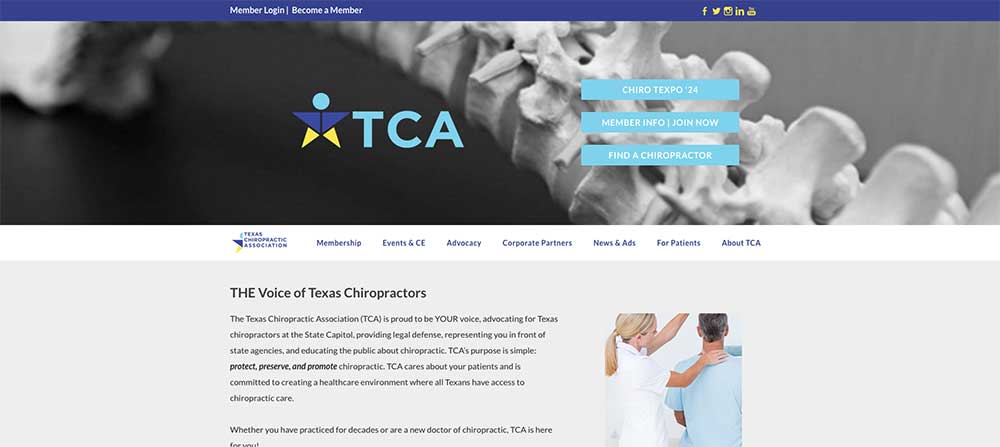Texas
Chiropractic Information

Texas Chiropractic Summary
Practice of chiropractic includes the treatment through manipulation/adjustment of the spine and other skeletal structures. All examinations performed by chiropractors shall be in accordance with the protocol and procedures as taught in the majority of accredited chiropractic colleges.
Licensing Requirements
Post-Licensing Education
Continuing Education requirements
You need 32 Board approved C.E. hours (16 each year) to renew your D.C. license. Each licensee’s reporting year shall begin on the first day of the month in which the licensee’s birthday occurs. Link: http://www.tbce.texas.gov/faq-Education.html
requirements for educators
A sponsor may submit an application no later than 60 days prior to the date of the course, along with a nonrefundable application fee for each course. Link: http://www.tbce.texas.gov/sponsor.html
Are PACE courses accepted for continuing education requirements?
Accepts PACE Precheck
Texas requires examinations through the National Board of Chiropractic Examiners
Part I, Part II, Part III, Part IV, Physiotherapy
State Chiropractic Online Resources
Chiropractic Statutes and Regulations
Texas Occupations Code Chapter 201:
https://statutes.capitol.texas.gov/Docs/OC/htm/OC.201.htm
22 Texas Administrative Code, Part 3, Chapters 71-82:
https://texreg.sos.state.tx.us/public/readtac$ext.ViewTAC?tac_view=3&ti=22&pt=3
Solicitation of Patients (Texas Occupations Code Chapter 102):
https://statutes.capitol.texas.gov/Docs/OC/htm/OC.102.htm
Telemedicine and Telehealth (Texas Occupations Code Chapter 111):
https://statutes.capitol.texas.gov/Docs/OC/htm/OC.111.htm
Training Course on Human Trafficking Prevention (Texas Occupations Code Chapter 116):
https://statutes.capitol.texas.gov/Docs/OC/htm/OC.116.htm
Massage Therapy (Texas Occupations Code Chapter 455):
https://statutes.capitol.texas.gov/Docs/OC/htm/OC.455.htm
Medical Radiologic Technologists (Texas Occupations Code Chapter 601):
https://statutes.capitol.texas.gov/Docs/OC/htm/OC.601.htm
Medical Records Privacy (Texas Health and Safety Code Chapter 181):
https://statutes.capitol.texas.gov/Docs/HS/htm/HS.181.htm
Administrative Procedure (Texas Government Code Chapter 2001):
https://statutes.capitol.texas.gov/Docs/GV/htm/GV.2001.htm
State Government Resources
State Legislature Homepage
State Legislature Bill Search Tool
Legislative member roster
State Governor's Office
Secretary of State
Office of the Insurance Commissioner
State Associations
State Chiropractic Coverage
Worker’s Compensation
Texas Department of Insurance: https://www.tdi.texas.gov/wc/index.html
Health Care Provider Training and Resources: https://www.tdi.texas.gov/wc/hcprovider/index.html
Workers Comp Fee Schedule and Reimbursement Policy: https://www.tdi.texas.gov/wc/fee/index.html
Medicaid
Texas Health and Human Services https://www.hhs.texas.gov/services/health/medicaid-chip
Medicaid Fee Schedule https://public.tmhp.com/FeeSchedules/
Practice Options
| Perform extremity adjustments? | Y |
| Provide nutritional advice? | Y10 |
| Provide manipulation under anesthesia? | N |
| Provide school enrollment exams? | Y1 |
| Provide sports physical exams? | Y2 |
| Provide return to play exams (including concussion protocol) for sports participation? | Y3 |
| Perform US Department of Transportation exams? | Y4 |
| Treat animals? | Y5 |
| Perform acupuncture? | Y6 |
| Perform dry needling? | Y7 |
| Perform intraoral TMJ treatments? | Y |
| Perform internal coccyx adjustments? | N/A |
| Are there limits to body areas DCs are allowed to examine and/or treat? | Y8 |
| Are there limits on diagnostic tools DCs are allowed to use? | Y9 |
| Perform venipuncture? | Y |
| Perform casting? | N |
1. While the Board considers physical exams to be within the scope of practice, the decision whether to accept an exam done by a chiropractor is up to the entity requesting the exam. The Board recommends you first check with the particular school or agency before doing an exam.
2. While the Board considers physical exams to be within the scope of practice, the decision whether to accept an exam done by a chiropractor is up to the entity requesting the exam. The Board recommends you first check with the particular school or agency before doing an exam.
3. Chiropractors can serve on school district concussion oversight teams, which establish return-to-play protocols.
4. A chiropractor can perform a Department of Transportation (DOT) physical exam if they are a certified medical examiner (CME) listed on the Federal Motor Carrier Safety Administration’s (FMCSA) National Registry.
5. Licensed chiropractors who are certified in animal chiropractic can treat pets with a referral from a veterinarian. A veterinarian referral form must be completed and signed by both the owner and veterinarian before a pet can receive chiropractic care. Must be AVCA certified.
6. Chiropractors must obtain a permit from the Texas Board of Chiropractic Examiners (TBCE) to practice acupuncture.
7. The Texas Administrative Code allows chiropractors to use needles in their practice, but only under certain standards. They cannot use needles for surgical or incisive procedures.
8. A chiropractor in Texas cannot do the following: Perform surgical procedures, prescribe controlled substances, dangerous drugs, or any drug requiring a prescription, use incisive needles (other than for drawing blood for diagnostic purposes), use X-rays or other radioactive procedures for therapeutic purposes, perform or prescribe solely cosmetic treatments, perform manipulations under anesthesia. Link: http://www.tbce.texas.gov/faq-sop.html
9. Chiropractors are prohibited from the use of diagnostic or therapeutic procedures that include the use of drugs, surgery, cauterization, desiccation or coagulation of tissues, rectal examinations, gynecological examinations, obstetrics, catherization with a needle, injecting of dyes for radiological procedures, lumbar puncture to obtain spinal fluid, treatment of cancer or x-ray therapy.
10. Nutritional advice and treatment must relate specifically to MSK conditions.




